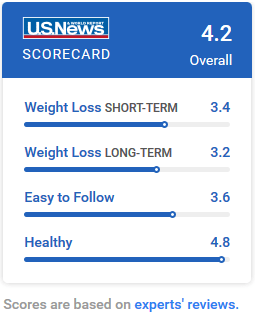For the seventh year in a row, U.S. News & World Report has named the plant-based eating plan as the best choice overall, followed by the Mediterranean diet, up from fourth place last year. Each panelist considered the 38 diets across a number of areas, including the likelihood of sticking to the diet, the odds of losing weight in the short- and long-term, and effectiveness against heart disease and diabetes.
The DASH and the Mediterranean diets, as well as most of the other recommended diets, focus on eating whole grains, fruits, vegetables, low- or no-fat dairy, lean meats, poultry and fish. They also recommend nuts, seeds and legumes (beans).
DASH DIET: One reason the DASH diet came in first is that it was developed and tested by the U.S. National Institutes of Health. Nutrients like potassium, calcium, protein and fiber are crucial to fending off or fighting high blood pressure. You don’t have to track each one, though. Just emphasize the foods you’ve always been told to eat (fruits, veggies, whole grains, lean protein and low-fat dairy), while shunning those we’ve grown to love (calorie- and fat-laden sweets and red meat). Top it all off by cutting back on salt, and voila!
For a 2,000-calorie diet, you should shoot each day (unless otherwise noted) for six to eight servings of grains; four to five each of veggies and fruit; two to three of fat-free or low-fat dairy; six or fewer of lean meat, poultry and fish, with one serving being equivalent to an ounce; four to five (a week) of nuts, seeds and legumes; two to three of fats and oils; and five or fewer (a week) of sweets. DASH suggests capping sodium at 2,300 milligrams a day and eventually working to stay at about 1,500 milligrams.
Tips on Switching to the DASH Eating Plan
• Change gradually. Add a vegetable or fruit serving at lunch and dinner.
• Use only half the butter or margarine you do now.
• If you have trouble digesting dairy products, try lactase enzyme pills or drops—they’re available
• at drugstores and groceries. Or buy lactose-free milk or milk with lactase enzyme added to it.
• Get added nutrients such as the B vitamins by choosing whole grain foods, including whole
• wheat bread or whole grain cereals.
• Spread out the servings. Have two servings of fruits and/or vegetables at each meal, or add
• fruits as snacks.
• Treat meat as one part of the meal, instead of the focus. Try casseroles, pasta, and stir-fry dishes.
• Have two or more meatless meals a week.
• Use fruits or lowfat foods as desserts and snacks.
And stick to a regular physical activity program.
Happy thinner you.


